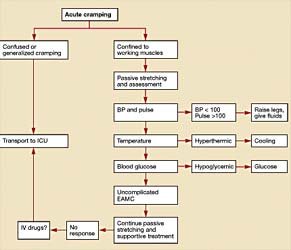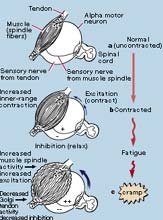- Back of lower leg/calf (gastrocnemius).
- Back of thigh (hamstrings).
- Front of thigh (quadriceps).
Cramps in the feet, hands, arms, abdomen and along the rib cage are also very common. Muscle cramps range in intensity from a slight tic to agonizing pain. A cramping muscle may feel hard to the touch and/or appear visibly distorted or twitch beneath the skin. A cramp can last a few seconds to 15 minutes or longer. It might recur multiple times before it goes away.

Why Cramps Happen

Although the exact cause of muscle cramps is unknown (idiopathic), some researchers believe inadequate stretching and muscle fatigue leads to abnormalities in mechanisms that control muscle contraction. Other factors may also be involved, including exercising or working in intense heat, dehydration and depletion of salt and minerals (electrolytes).
Stretching & Muscle Fatigue:
Muscles are bundles of fibers that contract and expand to produce movement. A regular program of stretching lengthens muscle fibers so they can contract and tighten more vigorously when you exercise. When your body is poorly conditioned, you are more likely to experience muscle fatigue, which can alter spinal neural reflex activity. Overexertion depletes a muscle’s oxygen supply, leading to build up of waste product and spasm. When a cramp begins, the spinal cord stimulates the muscle to keep contracting.
Heat, Dehydration & Electrolyte Depletion:
Muscle cramps are more likely when you exercise in hot weather because sweat drains your body’s fluids, salt and minerals (i.e., potassium, magnesium and calcium). Loss of these nutrients may also cause a muscle to spasm.

Who Gets Cramps?

Just about everyone will experience a muscle cramp sometime in life. It can happen while you play tennis or golf, bowl, swim or do any exercise. It can also happen while you sit, walk or even just sleep. Sometimes the slightest movement that shortens a muscle can trigger a cramp.
Some people are pre-disposed to muscle cramps and get them regularly with any physical exertion. Those at greatest risk for cramps and other ailments related to excess heat include infants and young children, people over age 65, and those who are ill, overweight, overexert during work or exercise, or take drugs or certain medications. Muscle cramps are very common among endurance athletes (i.e., marathon runners and triathletes) and older people who perform strenuous physical activities.
Athletes are more likely to get cramps in the preseason when the body is not conditioned and therefore more subject to fatigue. Cramps often develop near the end of intense or prolonged exercise, or the night after. Older people are more susceptible to muscle cramps due to normal muscle loss (atrophy) that begins in the mid-40s and accelerates with inactivity. As you age, your muscles cannot work as hard or as quickly as they used to. The body also loses some of its sense of thirst and its ability to sense and respond to changes in temperature.

Treatment & Prevention

Cramps usually go away on their own without seeing a doctor.
For Self-Care:
- Stop doing whatever activity triggered the cramp.
- Gently stretch and massage the cramping muscle, holding it in stretched position until the cramp stops.
- Apply heat to tense/tight muscles, or cold to sore/tender muscles.
To avoid future cramps, work toward better overall fitness. Do regular flexibility exercises before and after you work out to stretch muscle groups most prone to cramping. Always warm up before stretching.
Calf Muscle Stretch: View
In a standing lunge with both feet pointed forward, straighten the rear leg. (Repeat with opposite leg.)
Hamstring Muscle Stretch: View
Sit with one leg folded in and the other straight out, foot upright and toes and ankle relaxed. Lean forward slightly, touch foot of straightened leg. (Repeat with opposite leg.)
Quadriceps Muscle Stretch: View
While standing, hold top of foot with opposite hand and gently pull heel toward buttocks. (Repeat with opposite leg.)
Hold each stretch briefly, then release. Never stretch to the point of pain.
To prevent cramps, you should also keep your body adequately hydrated. Children especially often do not drink enough liquids to replenish fluid lost during exercise. Some tips:
- Drink water at regular intervals, before you get thirsty.
- Drink more than your thirst requires.
- Drink fruit juice or a sports beverage if you are working in heat or sweating for more than an hour.

When To See The Doctor

Although most muscle cramps are benign, sometimes they can indicate a serious medical condition. See your doctor if cramps are severe, happen frequently, respond poorly to simple treatments or are not related to obvious causes like strenuous exercise. You could have problems with circulation, nerves, metabolism, hormones, medications or nutrition.
Muscle cramps may be a minor part of many conditions such as Lou Gehrig’s disease (amyotrophic lateral sclerosis), spinal nerve irritation or compression (radiculopathy), hardening of the arteries, narrowing of the spinal canal (stenosis), thyroid disease, chronic infections and cirrhosis of the liver.
Give the doctor your medical history including details about allergies, illnesses, injuries, surgeries, and medications. How long have you experienced cramps? Is there a family history of the problem? Do your cramps occur only after exercise, or do they happen while at rest? Does stretching relieve the cramps? Do you have muscle weakness or other symptoms? Your doctor may want to take a routine blood test to rule out diseases.
References:
- Medline Plus “Muscle Cramp�, March 2001.
- Medicine Net “Muscle Cramps (Of skeletal muscles)�, 1990.
- Arch Intern Med “Muscle Cramps�, 1990.
- Better Bodz “Muscle Cramps�, May 2003.
Thanks,


